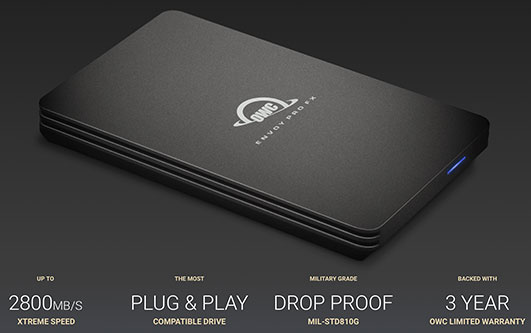
$220 SAVE $130 = 37.0% Western Digital 16.0TB Western Digital Ultrastar DC HC550 3.5-in… in Storage: Hard Drives
|

|

|

|

|
Concussion: Post-Crash Recovery Phase 5, Full Recovery Emerges, Well, Maybe
Related: concussion, double century, exercise, hard core, health, heart rate, Mercedes Sprinter, Moots, Moots Vamoots RSL, resting heart rate, ultra endurance exercise
Legal disclaimer: Since we are not doctors, never follow anything based on health-related topics on this or related sites without first consulting with your doctor or other trusted health professional. OTOH, the study of brain injuries is at best in its infancy, like studying outer space with primitive telescopes.
Lloyd’s view from the personal experience of having healed himself is that possibly excepting a few groundbreaking clinics, sadly most doctors (including neurologists) have little insight into the best way to recover from a mild traumatic brain injury. Not only that, there is a large professional reservoir of false cognitive commitments about brain function, the best example being the recently proven fact that neuroplasticity does not cease after childhood, and indeed endures into old age. Search the web—the medical literature is a vast uncharted desert as of 2018, even for the acute phase. The field is only now getting the attention it deserves. See two recommended books which have solid suggestions.
Every concussion is *personal* and there is no timeline or one-size-fits-all approach. There is/was no expert concussion specialist in his densely populated urban area that Lloyd could turn to—none. Indeed the ER physicians were totally clueless about what to do after leaving the ER giving not just bad, but extremely risky advice (“OK to do go back to work, to ride a bike right away”)—worse than anything else they could have said. Just stating “we are totally ignorant about how to recover” would have been much better, and at least honest. I am adamant on this point, based on my own recovery trajectory.
About this page
This page begins with the first day on which full normalcy was perceived, including mental and physical alertness all day without a need for a nap or early bedtime.
Continued from Concussion Recovery Phase 4, continues in Concussion Recovery Phase 6.
May 6, 48 days after crash
Sleep: 46°F @ 500'. 2 hour nap in evening after ride, then 22:30 to 9:30, solid sleep. MRHR=na.
Training has been going well (long bike rides). Hard to tell if extra sleep requirements are demands from training (surely at least partly) or concussion (probably half of it). Days are still “short” in that due to still needing more rest, I lose 3-4 hours a day total. The good news is no brain fade on any bike rides. It is good to feel nearly whole again.
I am now persuaded that the BEMER® is responsible for faster recovery from workouts, and might have been the kickstart that got rid of the brain fade since there has been no brain fade starting 2 days after starting to use it (head and body), and I’ve now been using it and riding hard and long for 10 days.
What will be interesting is whether I can win the Central Coast Double—probably not as I am way off schedule on weight, being 7 pounds heavier than planned for pre-concussion—that hurts big time on the climbs and also fatigues muscles faster.
May 3, 47 days after crash
Sleep: 48°F @ 500'. 22:15 => 03:00 very tired at bedtime then 03:30 to 08:45, interrupted sleep, woke up restless at 3 AM. MRHR=na.
Felt a bit short on sleep at 08:45 and not all the time was sleep. Probably the workout, but also was taking delivery of new bike and did not get home until 21:30 last night. Legs need recovery but will still ride today—all systems go as far as brain for past 2 days.
May 2, 46 days after crash
Sleep: 49°F @ 500'. 21:15 => 07:15 solid long sleep. MRHR=about 50.
Felt well rested upon waking though legs and glutes noting yesterday’s very hard workout. I was used to it back in Jan/Feb but even then this intensity for 4-5 hours requires recovery, so all is well.
Rode again today at lower intensity, the point being to prove out brain-fade or not—no brain fade again today, which is a very encouraging sign! That I was able to complete this ride and with energy left over and no brain fade is a remarkable change from last week. I now have hopes of being able to do the Central Coast Double 10 days from now on May 12. The test is being able to sustain 50-60 miles per day for 7 days. I might fall a wee bit short of that, but if I allow 3 days rest prior, I think based on today and yesterday’s rides that I can do it.
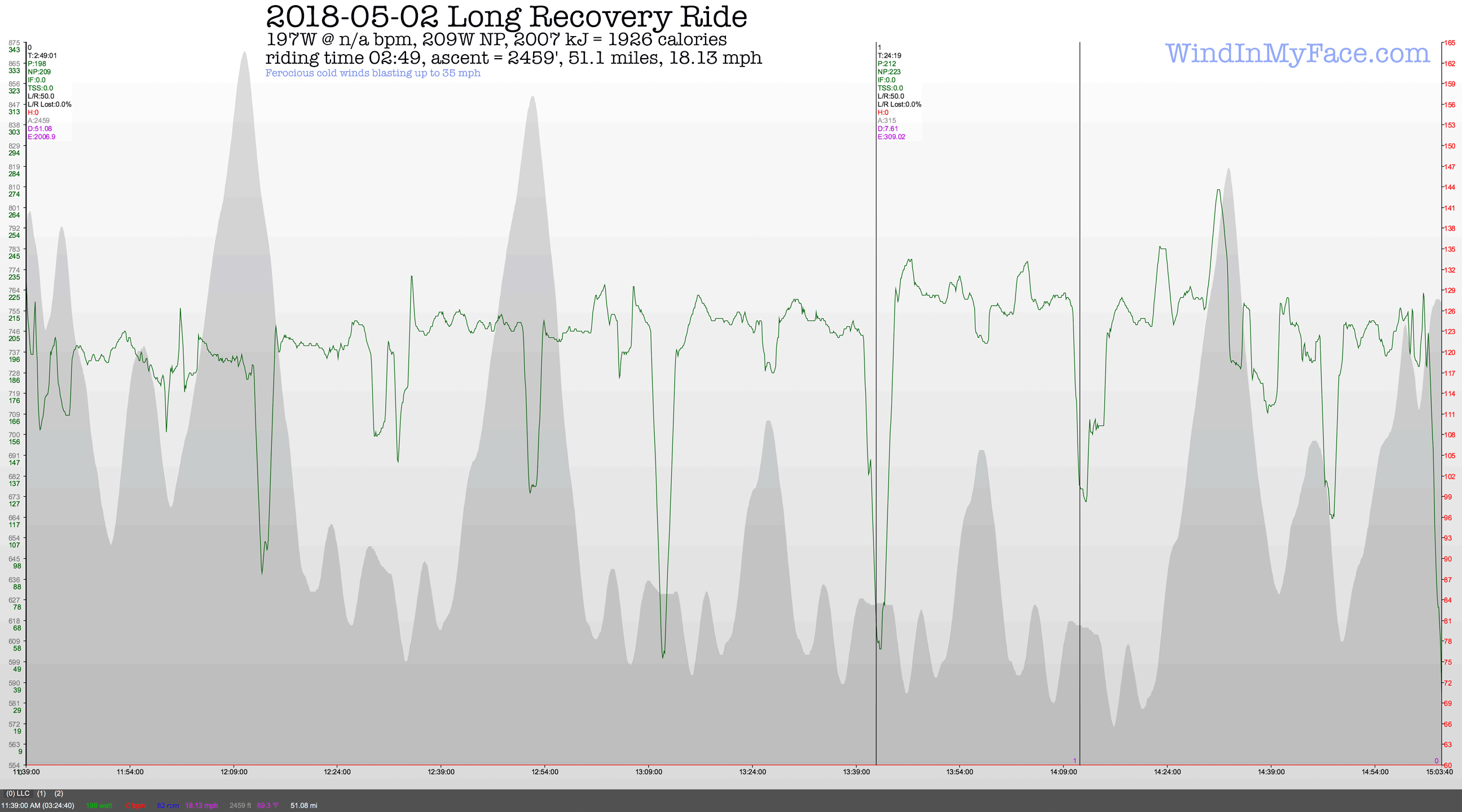
May 1, 45 days after crash
Sleep: 47°F @ 500'. 20:30 => 07:30 rest. Solid long sleep. MRHR=na.
Felt well rested upon waking. Good energy in morning and until 14:00. Rest of day TBD.
One of the telltale signs of incomplete brain recovery is that I ride strongly for a about 90 minutes as if everything were normal (as it is), but then (depending on intensity) somewhere around the 80 to 120 minute mark my brain starts losing kickstart and it feels like I want to shut my eyes and take a nap. That compared to pre-concussion robust endurance of riding 200 miles and stopping once in that 200 miles with no brain fade at all.
After 3 days of a demanding need for sleep/rest (45 hours of it over 3 days), today I had a breakthrough in being able to ride at pre-concussion pace for 3 hours 22 minutes and 2577 calories. For perspective, only a handful of riders in the state my age could match this effort; it is at a level that wins double centuries as with the first two this year. It felt good, but it took all my energy reserves and I have to sleep very soon, and that's after resting 90 minutes. Tomorrow I’ll know if it was too much. Next double is Central Coast Double on May 12. I am hoping my brain improves enough by May 9 (pre-test) to make that viable.
In the graph below, note the decreasing time for the intervals—this is the sign of a quality workout in which the body steps up to the plate and is willing. The key thing though is no brain fade (though I was very careful to take in enough glucose in the form of GU). Heart rate is very low for the effort (128 bpm), made possible by the high winds and temperature of about 58°F.
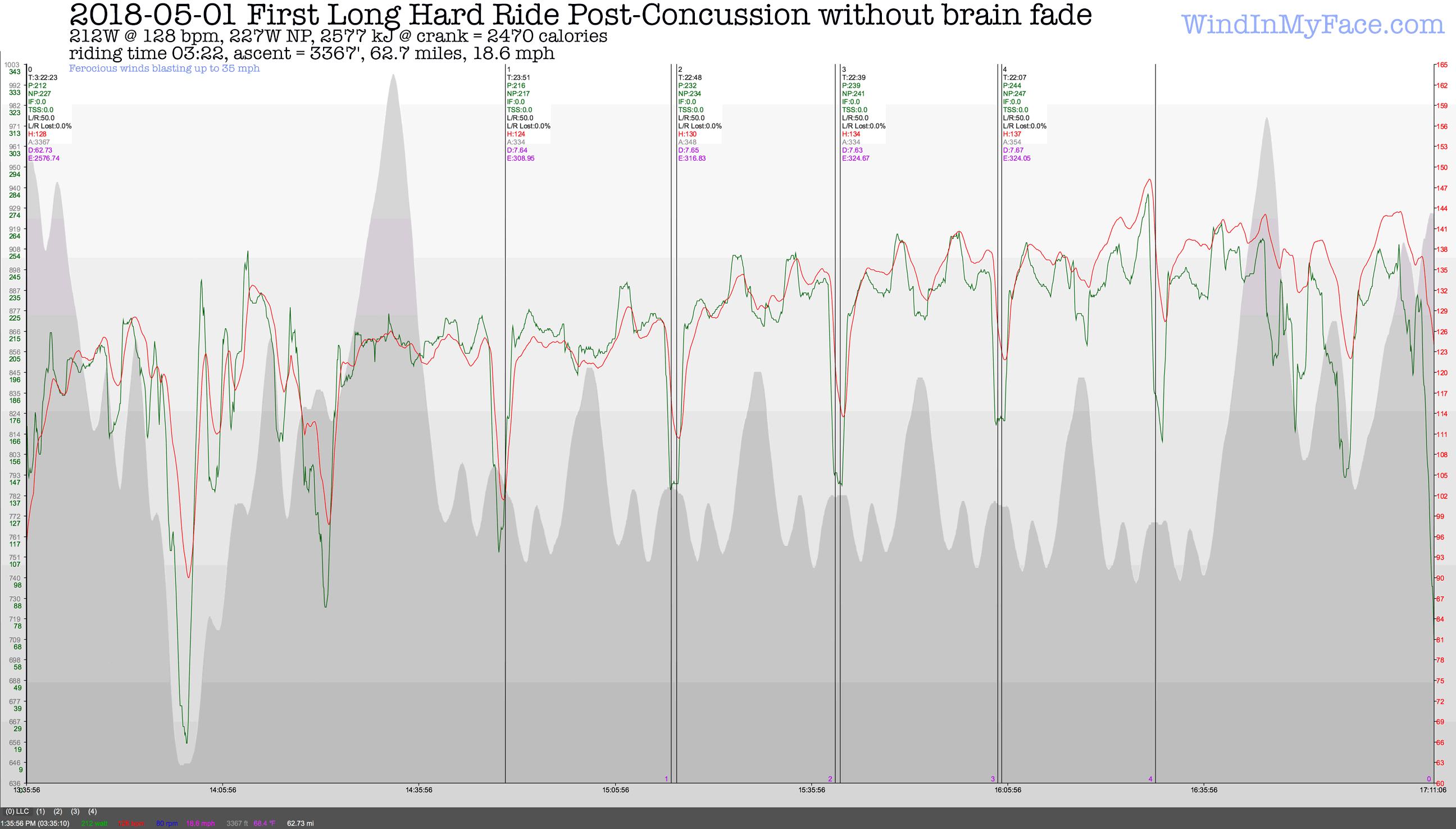
April 30, 44 days after crash
Sleep: 48°F @ 500'. 20:30 => 07:30 rest until 09:00. Solid sleep. MRHR=na.
Daily effects still have surprises. I have little to no idea of what to do about it—see yesterdays’ excessive sleep log.
Clearly sleep issues not resolved: slept 14:45 - 18:00, disoriented upon waking diddled about until 8:30 but so tired fell asleep waking only once to pee until 7:30 AM. Felt like body clock 12 hours off.
April 29, 43 days after crash
Sleep: 48°F @ 500'. 20:30 => 07:30 rest until 09:00. Solid sleep. MRHR=na.
Partially functional the morning to early afternoon, I had to take a nap from 2:45 PM to 7:10 PM, as if my body clock was off by 12 hours. Then I slept again from 8:30 PM t 7:30 AM. That's a lot of hours of sleep—is it catch-up from four good days from April 24-247? I don’t feel bad in any particular way, though I do feel a low-level anxiety and stress. I ’d like to head back to the forest to rest, but I cannot—too many bills too pay and not enough money, for starters, along with an unexpected roof replacement (non-repairable) that is damaging the interior, which will cost $25K to $40K—and I don’t have the money. Stress enough trying to figure that one out and taking on yet more debt is just a deeper financial hole. Too bad Obama stole $180K from me over the past 8 years via the vicious assault of the Unaffordable Care Act.
April 28, 42 days after crash
Sleep: 48°F @ 500'. 20:30 => 07:30 rest until 09:00. Good solid sleep in a week or more. MRHR=na.
Excellent night’s sleep from 8:30 PM, woke up once, disoriented, thinking I was somewhere in the national forest! Felt better in the morning after total exhaustion last night at 8:30 PM.
Clearly the effects of the concussion are not gone. While pre-concussion I could ride 200 miles stopping only once and win, now I encounter mental fatigue in the 80 to 120 minute range, making me want to close my eyes and nap.
April 27, 41 days after crash
Sleep: 52°F @ 500'. 22:15 => 5:45 => 7:30. Best sleep in a week or more. MRHR=47 but after I had gotten up.
I went to bed at 22:15 last night and had the best night’s sleep in a week or more. Was it the wonderfully relaxing effects of the BEMER® or being short on sleep from the night before? Maybe some of both, but I don’t think it was coincidence as I can feel the relaxing and stimulating effects of PEMF even as it operates.
Surprisingly, the good night’s sleep did not result in a good day: this was one of those “4 steps forward, 1 step back” days. My head felt odd all day. Riding my bike for 90 minutes left me as 'toast' and I had to go to bed at 8:30 PM and slept until 7 AM, dozed and rested until 9 AM.
April 26, 40 days after crash
Sleep: 48°F in cabin @ 500'. Poor sleep, details below. MRHR=TBD but mostly 48/49 so not fully rested or recovered.
I went to bed at 22:10 last night and was almost asleep when a dark started barking (along with an echo, so it was like two dogs). I was not able to tune this out nor did I have ear plugs and it did not stop until 23:20 when the owners returned home. By that time I was thoroughly awake and was unable to sleep until 02:30. Woken at 7:45 AM by my kids commute, and at 8:15 AM by the garbage truck, I got only 4-5 hours. Home is a horrible place for peace and quiet. It makes me want to move to someplace peaceful.
I had become used to the blissful quiet of the national forest where only wind and birds are heard. Home is not restful: cars and trucks even 1/4 mile away can be heard, overhead airplanes (2 to 10 per hour), people talking a block or two away, morning leaf blowers and lawnmowers—it’s impressive how godawful it is in terms of noise, and I live in a far quieter area than 99% of bay area residents. I wonder how many millions of people suffer from noise-related stress and sleep issues simply because of the constant barrage. Without a concussion, we tend to tune it out. But it takes its toll nonetheless.
April 25, 40 days after crash
Sleep: 48°F in cabin @ 500. Poor sleep, details below. MRHR=45 but mostly 48/49 so not fully rested or recovered.
Up early at 6:15, I am feeling pretty normal in that being a bit short of sleep can be noticed, just like pre-concussion.
I drove the last leg home today, 346 miles and 07:40 minutes of driving. At no time did my attention lag while driving or otherwise, right up to bedtime. That is a huge improvement to normal from just a week ago. I did take one 30 minute rest/nap but this was only because of the too-short sleep the prior night. See tomorrow’s notes for the lousy night’s sleep notes.
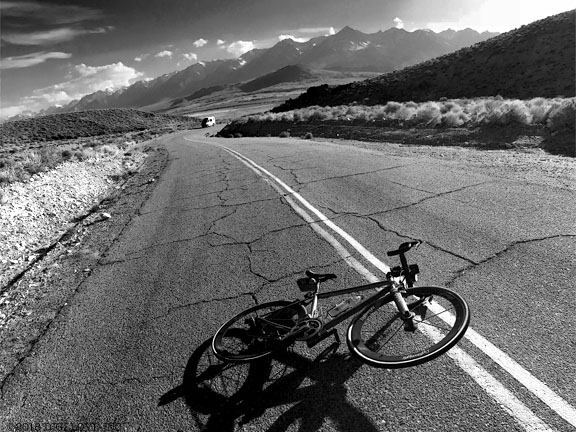
iPhone 7 Plus + iPhone 7 Plus 4.0 mm f/1.8 @ 4mm
[low-res image for bot]
April 24, 39 days after crash
Sleep: 38°F in cabin @ 5600'. Asleep at ~10:15 PST (11:15 equiv to MST), slept to 6:30 PST (7:30 MST) with 3 brief interruptions to pee. Slept soundly.. MRHR=40 strongly suggesting fully rested/recovered.
Up early at 6:30 AM PST (really 7:30 AM MST, time zone change). Like yesterday, I feel about as normal as I could hope for, with a MRHR of 40, suggesting that I am fully rested and recovered, even after a very long and demanding day yesterday.
As with previous days, more “sewing machine legs” which I first noticed on April 9th. Athletes might know this as the excess energy that when well rested that makes the muscles want to move hence the leg (or both) pump up and down via the foot/ankle as fast as 7-10 times per seconds. In all my life, I deem this GOOD as it means physically that things are rested and ready to go.
No need for nap, full attention over 4 hours of driving.
Cycling test shows that while I have full power as pre-concussion, there is a large loss of endurance which I am certain is mental (brain), not physical.
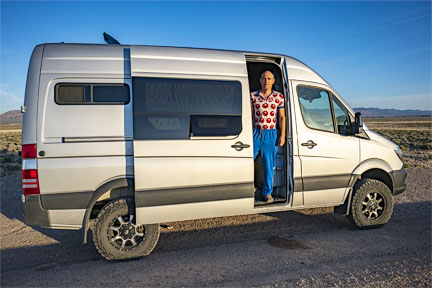
Sony A7R III + Zeiss Loxia 25mm f/2.4 Distagon
[low-res image for bot]
See also Rides — Hancock Summit.
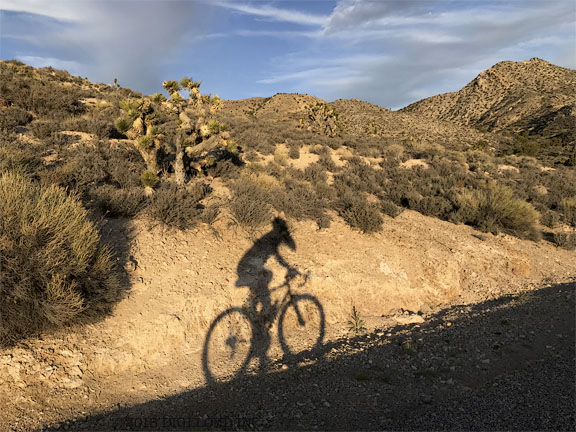
iPhone 7 Plus + iPhone 7 Plus 4.0 mm f/1.8 @ 4mm
[low-res image for bot]
April 23, 38 days after crash: fast new visual scan emerges after tDCS today
Sleep: down to 41°F in cabin @ 8000'. Asleep at ~23:30 with lots of energy, slept to 7:30 with 3 brief interruptions to pee. Slept soundly, some dreaming none remembered. Dozed until 8 AM and felt nicely alert at that time. MRHR=45-49 with high variability, a good sign of being rested even if rate is 3-5 beats higher than baseline.
Yesterday was a success in terms of mental and physical performance. Does a poor day follow a good one? Doesn’t feel so as of 8:30 AM—I feel alert and good.
Update 10 PM: I focused for about 3.5 hours without any particular effort to publish the first work in 5 weeks since the concussion. No loss of focus or fatigue other than the usual desire to stretch and over after that long in a chair. I then drove 6 hours, broken by a few very short stops and one one-hour bike ride. At no time did my attention flag while driving. This is the first day in which I felt 100% (not just 90%) normal. No sleepiness, no naps or need to take one.
It appears that some brain rewiring has booted up and come online today—a new skill or rather a much improved one, just like the “pain banishment” skill I developed about 2 weeks ago. To explain: a few days ago I noticed myself using my eyes to quickly scan near/far/left/right/up/down, that is, without head movement. I noted this but it did not seem particularly significant, although I seemed to be doing so more than I can ever recall. Today, some last puzzle piece of neural wiring fell into place: for the entire 6 hour drive I could do this intensive scan at very high speed, noting many objects across my visual field very quickly and having them register consciously. I do not recall ever being able to do that so quickly and efficiently before. I even played a game of mentally putting a 3:2 picture frame over a portion of the landscape and doing so quickly near and far and over yonder. This “fast visual scan” is an extremely useful skill for driving, but it is especially important in cycling, where scanning the road surface and everything around and doing so at high speeds is what helps one avoid things like potholes.
No need for nap, 6+ hours driving 330 miles with full attention.
What prompted today’s “fast visual scan” breakthrough? I have a hunch that it was in the works and my use (abuse) of the Halo Sport @AMAZON for tDCS (trans-cranial direct current stimulation) over the dorsolateral prefrontal cortex might have poked things just enough, engaging neuroplasticity (as it is designed to do) and accelerating the visual scanning learning. It’s a hassle using the Halo Sport @AMAZON for that area of the brain because the headphones are designed to fit like, well, headphones in order to stimulate the motor cortex. To make it work on the dorsolateral prefrontal cortex requires mashing the thing against the skull to keep electrical contact.
At much lower cost than Apple, with more options.
Lloyd recommends 64GB for iMac or Mac Pro for photography/videography.
April 22, 37 days after crash
Sleep: down to 29°F in cabin @ 8500'. asleep at ~22:20 (tired to point of achy), slept to 6:45 with two brief interruptions to pee. Slept soundly, no recollection of dreams. Dozed until 8 AM and felt reasonably alert at that time. MRHR=44+= good albeit not the 42 of April 17.
Yesterday’s daytime demanding need for sleep is a puzzler: how do I determine if this is a concussion after-effect or some other cause? Most disturbing is the idea that after 90 minutes I could feel more tired than after riding 200 miles pre-concussion. When and why that will happen now becomes a focus for final recovery. It feels like brain fatigue in which case I am a long way off from being able to comfortably and safely complete a double century. On the other hand, back on April 17 I rode for a total of about 5 hours (with picture-taking breaks) including one very hard effort up the main canyon road in Zion. That morning my MRHR was 42, a sign of being well rested.
No naps today and only a mild and easily controlled desire to do so.
Update 20:30: I went for a nearly two hour ride today, late in the afternoon. I started to get that sleepy feeling. On a hunch I had a GU (100 calories, turns into glucose in bloodstream starting in 5 minutes)—perked up again—did this a 2nd time with same positive result. My working theory is now this: at an elevation of 8000+ ft / 2440 meters, dishing out 230 to 250 watts is burning much more glucose than at sea level, due to hypoxia (low oxygen). While this has not been an issue pre-concussion at elevation, my post-concussion brain is probably extra sensitive to any drop in glucose. I can test this theory in a few days when I return home. Here at 20:30 as I write this, I feel perky and good.
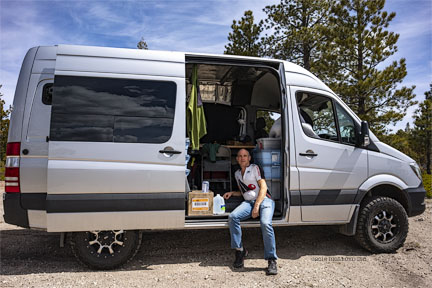
Sony A7R III + Zeiss Loxia 25mm f/2.4 Distagon
[low-res image for bot]
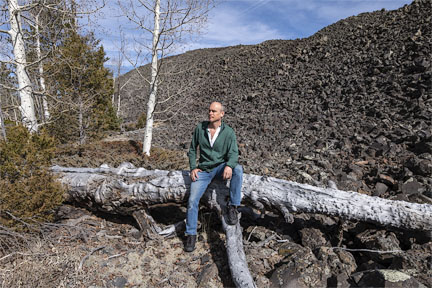
NIKON D850 + Nikon AF-S 14-24mm f/2.8G ED @ 24mm
[low-res image for bot]
See also: Rides — Bryce Canyon National Park.
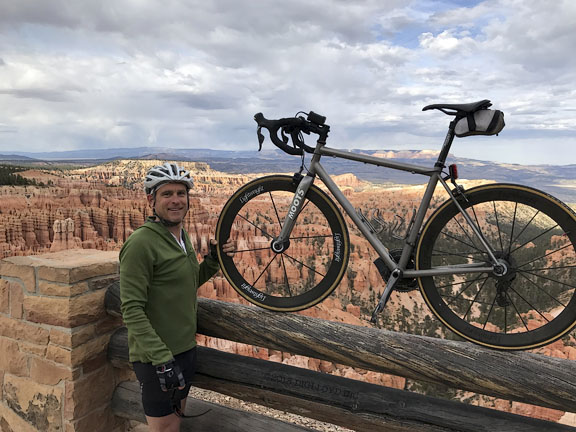
iPhone 7 Plus + iPhone 7 Plus 4.0 mm f/1.8 @ 4mm
[low-res image for bot]
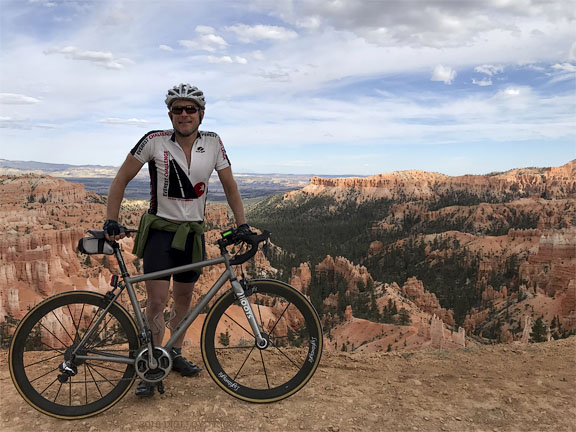
iPhone 7 Plus + iPhone 7 Plus 4.0 mm f/1.8 @ 4mm selfie
[low-res image for bot]
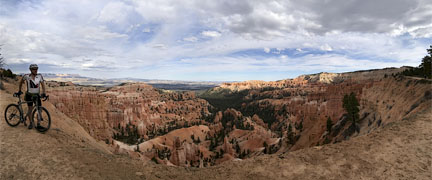
iPhone 7 Plus + iPhone 7 Plus 4.0 mm f/1.8 @ 4mm
[low-res image for bot]
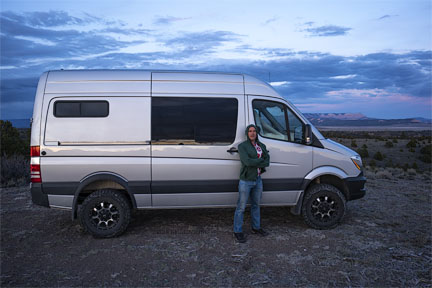
Sony A7R III + Zeiss Loxia 25mm f/2.4 Distagon selfie
[low-res image for bot]
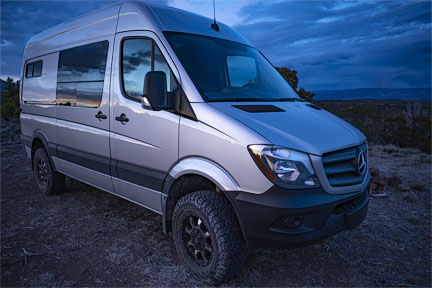
Sony A7R III + Zeiss Loxia 25mm f/2.4 Distagon
[low-res image for bot]
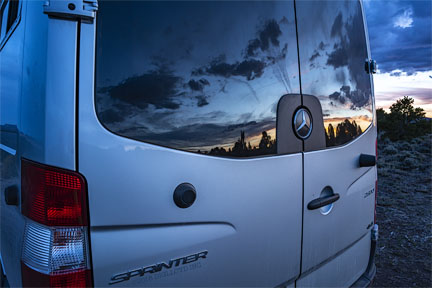
Sony A7R III + Zeiss Loxia 25mm f/2.4 Distagon
[low-res image for bot]
April 21, 36 days after crash
Sleep: down to 26°F in cabin @ 8200'. ~21:00 - 06:00. Awoke 6 AM. No recollection of dreams. MRHR=50 = warning sign, should be 42.
In spite of “pushing it” yesterday and waking at 6 AM, I got a good night’s sleep of ~8 hours and while I sense that another hour would have been better, I feel good this morning—see yesterday’s hopeful prognosis.
Update, 11:15 AM: after eating breakfast and writing for 45 minutes, I felt clearly that I hadn’t slept enough—not so much being sleepy as having that sense. Lying down and thinking a short catch-up, I woke up 3.5 hours later, which is just about the amount of time the mid-day naps demanded for 4+ days in a row, excepting yesterday. So it seems that the sleep disturbance is not abated. I’m thinking that my brain has some daily clock that is not 24 hours per day. Well, one good day (yesterday) is better than none and I’ll take it at that for now, expecting things to resolve over time.
Update 16:30: wet out for a ride from 8400' to 9980' elevation with the intention of riding 4 hours or so, as a first endurance test. I felt strong for the first 70 minutes, but began to feel lackluster at about 75 minute mark, declining rapidly in vigor/attention, to end with 91 minutes or riding. The decline felt to be cognitive, with a desire to close eyes and sleep, something that could not be fought off upon return—slept nearly 2 hours and had to struggle mightily to become awake and to fend off more sleep. Feels like body is 12 hours off eg like 5 AM at actual time of 5 PM. Around 19:30, began to feel alert again, notably alert at 20:30, and this continued until about 22:00. Sleep came easily starting at ~22:15.
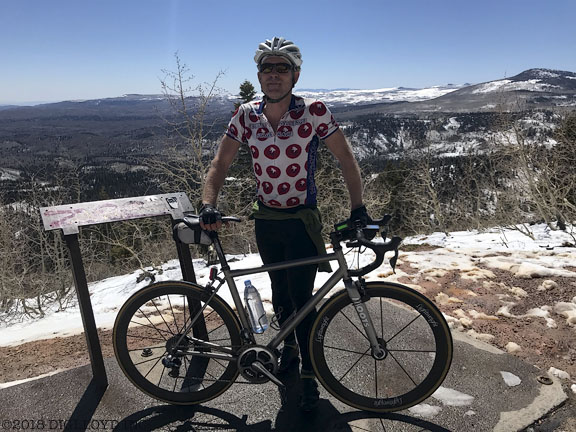
iPhone 7 Plus + iPhone 7 Plus 4.0 mm f/1.8 @ 4mm selfie
[low-res image for bot]
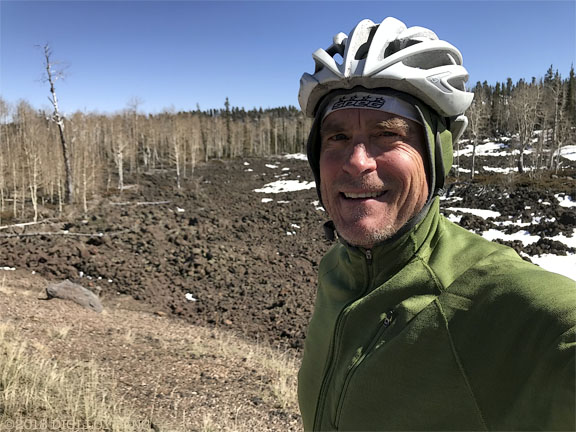
iPhone 7 Plus + iPhone 7 Plus 4.0 mm f/1.8 @ 4mm selfie
[low-res image for bot]

iPhone 7 Plus + iPhone 7 Plus back camera 6.6mm f/2.8 @ 57mm equiv (6.6mm)
[low-res image for bot]
April 20, 35 days after crash: √ first day of perceived normalcy
Sleep: down to 28°F in cabin @ 6800'. ~21:00 - ~01:00 rested but could not sleep. Awoke 6:30 AM. No recollection of dreams. MRHR=na.
I awoke this morning around 6:30 AM, having slept from about 1 AM, having rested but being unable to fall asleep from 9 PM until around 01 AM. This is (for me) woefully inadequate sleep and as is often the case, it was interrupted by the need to urinate several times (a years long age-induced condition). And yet today was the first day in 35 days that I felt 100% normal—no need for a nap, no sleepiness in the day, no need for an unusually early bedtime (to bed at ~21:30, a bit early but not overly so given the long day).
The pace of recovery has greatly accelerated the past week. Which I think should lend hope to anyone recovering from a concussion, that is, just when progress seems slow and dragging-on, improvement may accelerate all of a sudden. Stay positive and do what feels good and seems to help, and that is all one can do. What tomorrow will bring I cannot say, buy positive often builds on itself in a virtuous cycle.
My working theory about this apparently sudden onset of rapid improvement: some key level of repair is reached, which if respected, allows the remaining repair to proceed apace, unhindered by overdoing things, so long as one respects this—keeping cognitive demands moderate so as not to overload the available energy. Ditto for exercise well within one’s tolerance (very high for me being a double century rider, but not for most).
Also worth noting is that the past two weeks have been spent at an altitude of 6200 to 7800 feet / 1830-2387 meters elevation, with no ill effects. That said, I adapt very quickly to altitude (36 hours for a very large improvement) and have a VO2 Max in the 99.9th percentile. Not everyone may fare so well, so I recommend caution in terms of concussion recovery at high altitude and I do not recommend it during the early phases of recovery, since hypoxia places all sorts of additional physiological and adaptation demands on the brain and body.
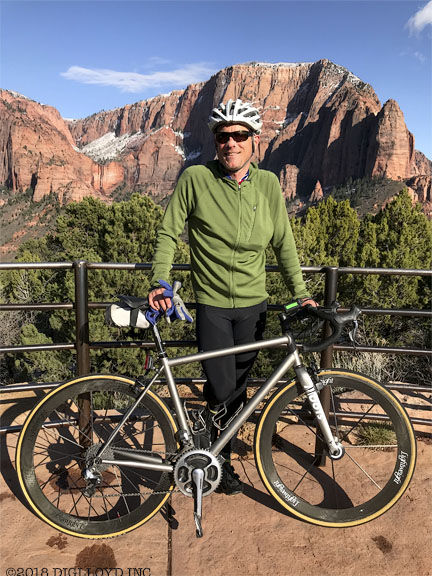
iPhone 7 Plus + iPhone 7 Plus 4.0 mm f/1.8 @ 4mm selfie
[low-res image for bot]
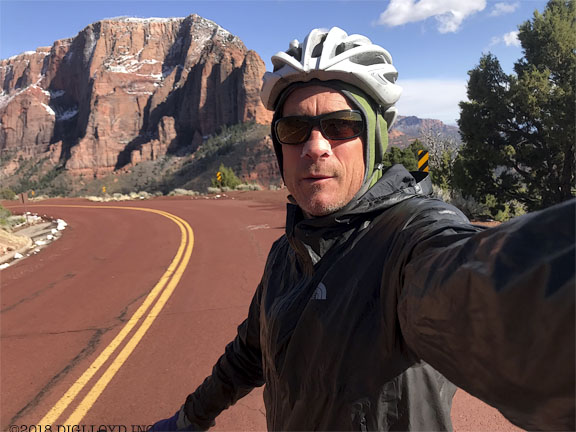
iPhone 7 Plus + iPhone 7 Plus 4.0 mm f/1.8 @ 4mm selfie
[low-res image for bot]
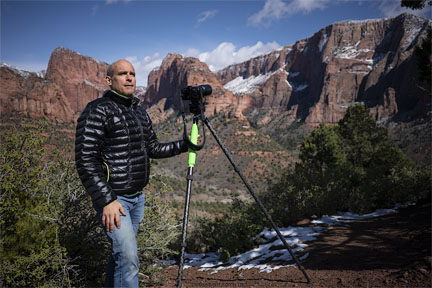
Sony A7R III + Zeiss Loxia 25mm f/2.4 Distagon
[low-res image for bot]
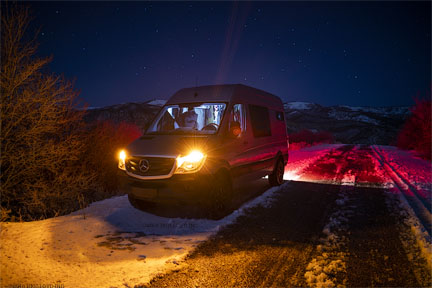
Sony A7R III + Zeiss Loxia 25mm f/2.4 Distagon
[low-res image for bot]
Seagate 22TB IronWolf Pro 7200 rpm SATA III 3.5" Internal NAS HDD (CMR)
SAVE $100



